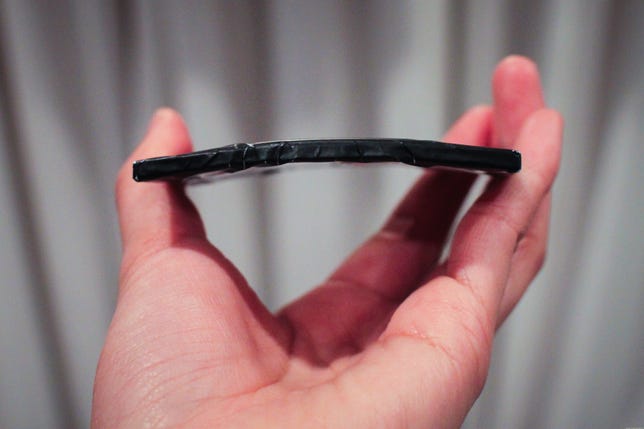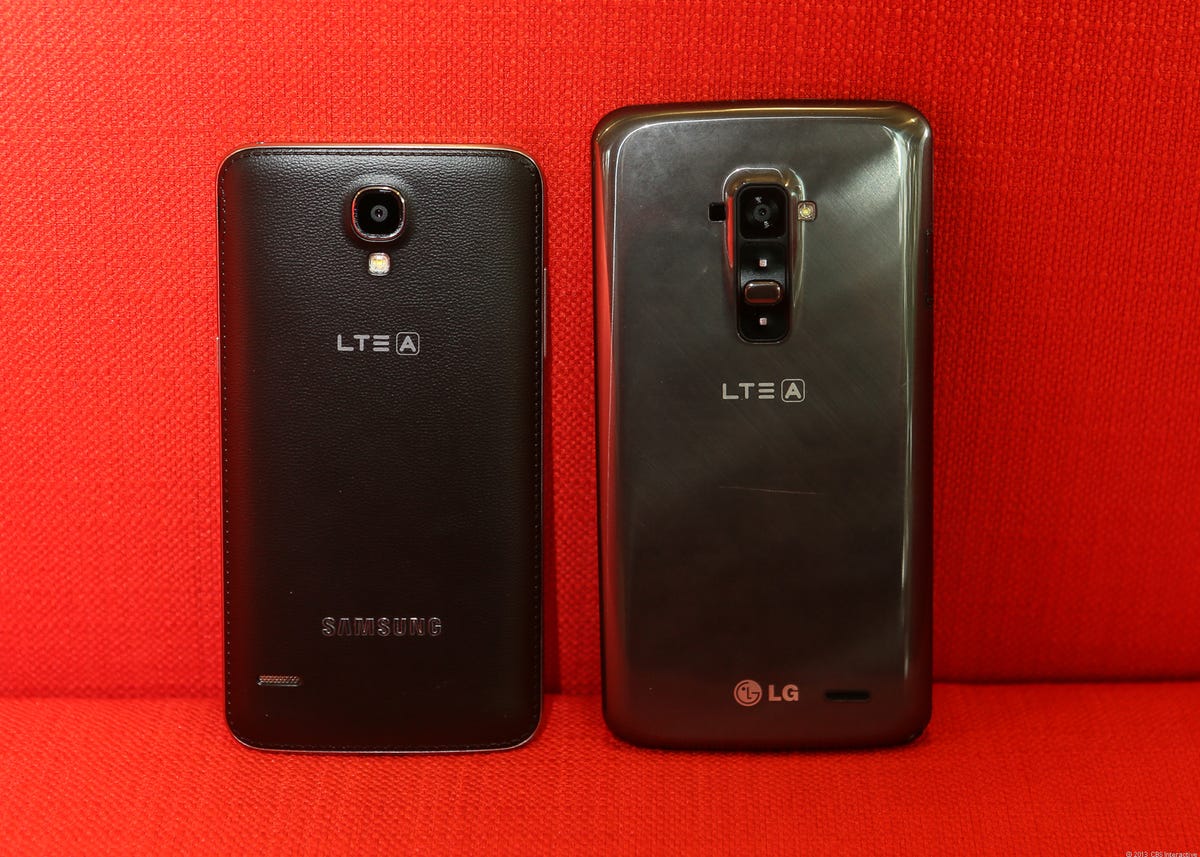Constant rivals Samsung and LG both brought smartphones with curved displays to market in South Korea this past November — the Samsung Galaxy Round and the LG G Flex. Although the G Flex is the only choice most buyers will have (it sells with AT&T, Sprint, and T-Mobile here in the US), it’s still worth comparing both approaches to the new curvy category side-by-side — and declare a winner.
Related stories
- Samsung’s Galaxy Round is greater than gimmick
- Review: LG’s innovative, bendy G Flex
- What you should know about flexible displays (FAQ)
- LG to launch flexible batteries — is bend the new black?
On the one side there’s the Galaxy Round, the first of the two to come to market, is a 5.7-inch Android 4.3 smartphone curves from edge to edge, but otherwise remains rigid.
On the other, LG’s G Flex arches its 6-inch display from head to toe. Its party trick: it’ll flatten without breaking when you press down on its back or face.
So which phone does bowed-screen better? We evaluated the curve, the specs, and real-world performance to find out.


Now playing:
Watch this:
LG G Flex flexes its bendy 6-inch screen
2:26
LG G Flex shows off its muscles (pictures)






+9 more
The comfiest curve to handle
In some cases, the orientation of the two phones’ curves is a little bit like arguing to-MAY-to or to-MAH-to. At some point, you’re probably going to use your phone in both portrait and landscape modes, so you’ll experience both horizontal and vertical curves.
Then again, the curve’s orientation does make a difference if you tend to carry phones in your pockets, hold them at your ear, and type frequently. Perhaps, too, because of its more gentle bend, LG’s Flex was less noticeable in back pockets than the Round, conforming more comfortably while walking and sitting. The Flex, too, was slightly better at typing in portrait mode, since the virtual keyboard remained on the same plane, instead of slightly coming forward at the sides.
The Round won out at the ear, partially because its curve-orientation, smaller size, and gently sloping edges make it easier to grip than the large, slick Flex.
Both Web sites and videos played back seamlessly and without any visual warping, but the phone’s curved shape was more apparent on the Flex. One of us didn’t mind that; the other thought that the peripheral view of the bend gave the phone more of a fun-house feel.
Ultimately, the tug-o-war over the better direction of the phone’s arch was for us a draw, and came down to personal preference depending on the activity at hand.


Now playing:
Watch this:
Curved Samsung Galaxy Round surprisingly comfy
2:16
Samsung’s deeply bowed Galaxy Round (pictures)






+8 more
Battle of the specs
Line up the specs (as we did below) and the phones look mostly equal, with a few trade-offs. The Flex has the larger screen and battery capacity, but the Round has the higher screen resolution and greater RAM. It also has a microSD slot for external storage, and a removable battery for those who care about such things.
table.geekbox th{background-color:#E6ECEF;text-align:left;font-weight:bold;}
table{width:620px;}
table.geekbox tr.even{background-color:#CCCCCC;}
.ratingGood{color:#093;} .ratingAverage{color:#666;} .ratingBad{color:#C00;}
| Phone | Samsung Galaxy Round | LG G Flex |
|---|---|---|
| Curve | Horizontal | Vertical |
| OS | Android 4.3 Jelly Bean | Android 4.2.2 Jelly Bean |
| Screen size | 5.7-inch AMOLED; 1,920×1,080 pixels, 386ppi | 6-inch AMOLED; 1,280×720 pixels, 245ppi |
| Processor | 2.3GHZ quad-core Snapdragon 800 | 2.2GHZ quad-core Snapdragon 800 |
| RAM | 3GB | 2GB |
| Internal storage | 32GB | 32GB |
| Expansion slot | Yes, up to 64GB | No |
| Battery | 2,800mAh; removable | 3,500mAh; embedded |
| Cameras | 13 megapixels; 2MP front-facing | 13 megapixels; 2.1MP front-facing |
| NFC | Yes | Yes |
| Dimensions (inches) | 5.9×3.1×0.31 | 6.3×3.2×0.31 |
| Weight (ounces) | 5.4 | 6.2 |
| US carrier | None announced (Korea) | Rumored: AT&T, Sprint, T-Mobile |
Credit: Jessica Dolcourt/CNET
While the camera capabilities match up on paper, Samsung’s quality and consistency edged out the Flex’s, while as we mentioned above, the Flex has the most pocket-friendly curves.
In terms of actual build quality, Samsung’s phone has the upper hand in terms of aesthetics and a thoughtful ergonomic hand-hold. It also helps that the Round’s side-to-side smile makes it narrower in the hand. LG’s cheaper-looking device is also narrower than a flat phone of the same size, and has the added benefit of a “self-healing” backing that rebuffs light scuffing as promised.
Bringing in the innovation
Although both handsets bring novel form factors to market, the G Flex has the leg up when it comes to breaking new and interesting ground.
For one thing, the Flex’s display actually does flex. Sure, you won’t be able to manipulate it like Play-Doh, but unlike the Round’s firm touch screen, LG’s device can withstand a decent flattening.


Lynn La/CNET
Not only can you press, sit, and step on it while it faces downward, but you can also have it face upward and push down against its sloping ends. In both situations, the Flex will bend and snap back into shape, with no damage.
Second, while the Round gets away with a straight and narrow battery located on the right side of the body, inside the Flex is a flexible battery that arcs as well.
LG said that developing a curved battery was actually harder than making a curved display. However, the company did succeed, and reported that the battery’s patented new shape helps with its reliability and stability. And while it’s hazardous to try and bend regular phone batteries casually with your hand, the Flex’s battery has to be just as agile as the device itself.
Aside from the Flex and other mobile gadgets that flaunt unique shapes like smartwatches, we don’t yet know exactly where this new breed of batteries will take us. But what we do know is that innovating the innards is just as important as changing cosmetics. LG’s initiative to explore new battery shapes (it also developed stepped and cabled batteries, too) is an exciting prospect in mobile technology, and the Flex gets props for being the company’s first smartphone to apply this new development.
And the better curved phone is…
Throughout this Samsung Galaxy Round and LG G Flex comparison, we’ve evaluated the devices based on these parameters: which phone curves the comfiest, which one has the most capable specs, and which is the most innovative.
Since there are slight pros and cons to having the two handsets arch in different directions, we’re calling this category a draw. We found both approaches to the bend comfortable, from north to south and from east to west, without much discernible difference when it comes to viewing and typing on the screens day-to-day. As for the latter two criteria, the Round delivers the more impressive specs, but the Flex offers captivating technology that would pique any futurist’s interest.


Josh Miller/CNET
At the end of the day, however, Samsung’s Galaxy Round is the superior smartphone. Its newer version of Android, sharper and crisper 1080p display, expandable memory, sounder construction, and sharper camera quality, prove more important and more satisfying than the Flex’s amenable nature when being sat on. The Flex is still a fine handset in its own right, but it just doesn’t have what it takes to outpace its Samsung rival.
Unfortunately, neither phone is on sale with a US carrier (die-hards can purchase the phones through independent distributor Negri Electronics for about $1,000), but we’re hoping CES brings some official announcements to this effect.
For now, both devices hope to usher in a new direction in smartphone design that encompasses both aesthetics and subtle practicality when holding and carrying the phones day-to-day. If a new era of deeply curved handsets is indeed upon us, these heavyweights’ competition will help work out the kinks for tomorrow’s curvy smartphones and wearable electronics.



